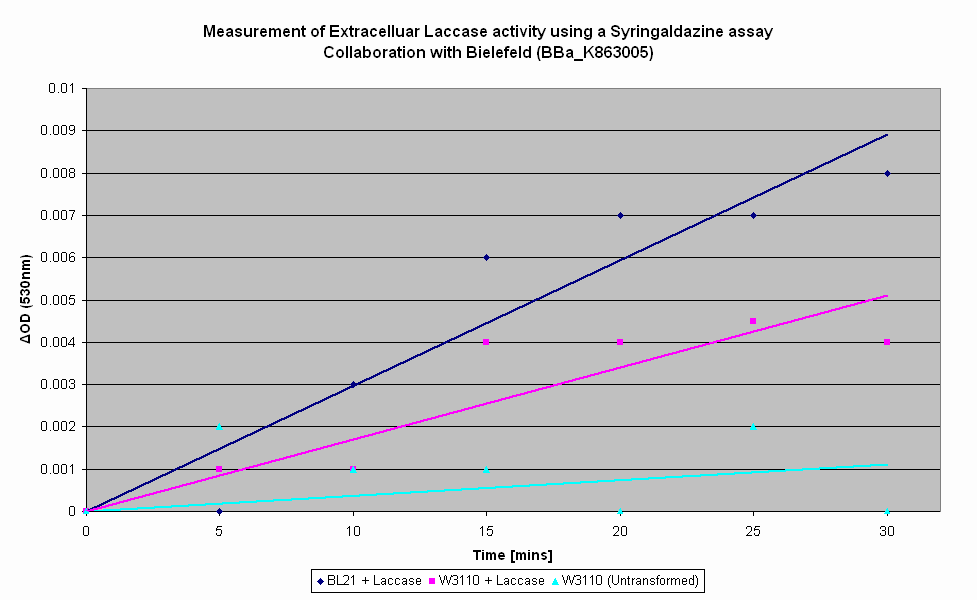Difference between revisions of "Part:BBa K863005:Experience"
Sednanalien (Talk | contribs) (→User Reviews) |
Sednanalien (Talk | contribs) (→User Reviews) |
||
| Line 25: | Line 25: | ||
<I>University College London 2012</I> | <I>University College London 2012</I> | ||
|width='60%' valign='top'| | |width='60%' valign='top'| | ||
| − | As part of our collaboration with Bielefeld-Germany, we have characterised their Laccase BioBrick utilising a Syringaldazine assay to determine their Laccase activity. Syringaldazine is oxidised by Laccase, causing a colourmetric change that can be observed by a spectrophotometer at 530nm. As seen in the graph below, | + | As part of our collaboration with Bielefeld-Germany, we have characterised their Laccase BioBrick utilising a Syringaldazine assay to determine their Laccase activity. Syringaldazine is oxidised by Laccase, causing a colourmetric change that can be observed by a spectrophotometer at 530nm. As seen in the graph below, the highest rate of Laccase production is in transformed BL21 cells - this is to be expected due to the T7 promoter, which requires T7 RNA polymerase that BL21 produces. However, expression in W3110, which does not produce T7 RNA polymerase, is still elevated above that of untransformed ''E. coli''. We hence conclude that Bielefeld-Germany's Laccase BioBrick is working as expected. |
[[Image:UniversityCollegeLondon_CollaborationLaccase.png|800px|centre]] | [[Image:UniversityCollegeLondon_CollaborationLaccase.png|800px|centre]] | ||
|}; | |}; | ||
Revision as of 15:28, 25 September 2012
This experience page is provided so that any user may enter their experience using this part.
Please enter
how you used this part and how it worked out.
Applications of BBa_K863005
User Reviews
UNIQc9d8ec819a4dfd77-partinfo-00000000-QINU UNIQc9d8ec819a4dfd77-partinfo-00000001-QINU
|
•••••
University College London 2012 |
As part of our collaboration with Bielefeld-Germany, we have characterised their Laccase BioBrick utilising a Syringaldazine assay to determine their Laccase activity. Syringaldazine is oxidised by Laccase, causing a colourmetric change that can be observed by a spectrophotometer at 530nm. As seen in the graph below, the highest rate of Laccase production is in transformed BL21 cells - this is to be expected due to the T7 promoter, which requires T7 RNA polymerase that BL21 produces. However, expression in W3110, which does not produce T7 RNA polymerase, is still elevated above that of untransformed E. coli. We hence conclude that Bielefeld-Germany's Laccase BioBrick is working as expected. |

